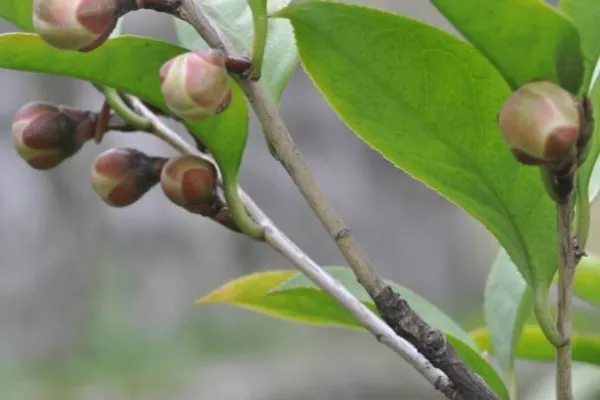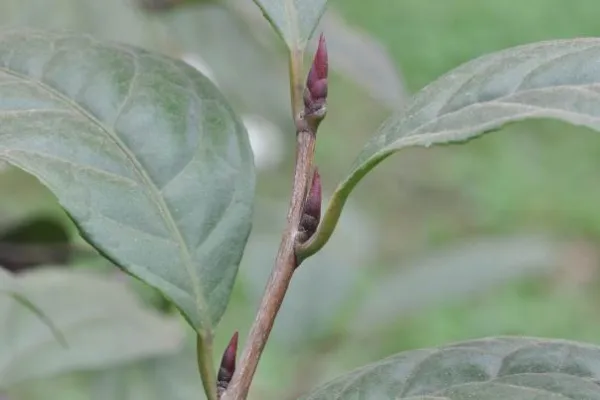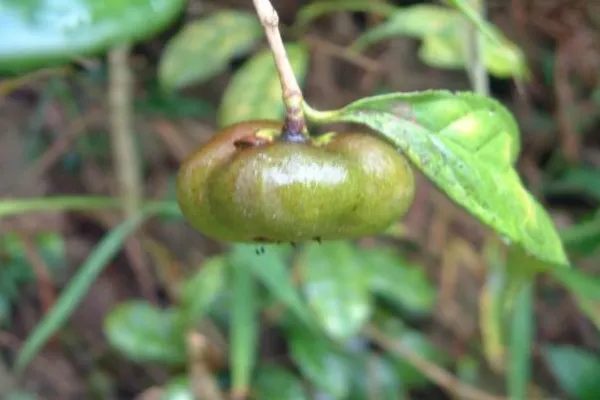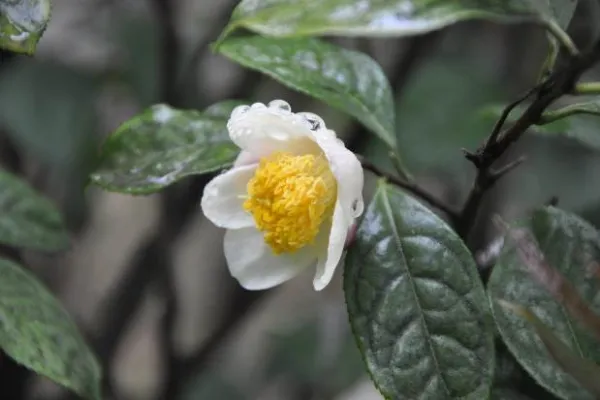Study of Camellia liberofilamenta
Yang Cheng-hua*, Deng Lun-xiu, Dai Xiaoyong
Guizhou Forestry Academy, Fuyuannan Road 382, Guiyang 550002
* author for correspondence, e-mail: 506029434@qq.com
Introduction
The species Camellia liberofilamenta Chang et C.H.Yang was published in 1997 (Zhang and Yang 1997). It is endemic to Guizhou, and belongs to Section Chrysantha. It is the most north species in this section as well as the yellow camellia group. The number of this plant is very few in the wild. In this paper, we would like to introduce this beautiful and scented species.
Morphological description and taxonomy treatment
Shrubs-like, up to 3m tall. Branches are glabrous, yellowish-white. Leaves are thin coriaceous, elliptic, 6-13cm long, 3.5-5.5cm wide, apex acute, base broadly cuneate, fine black glandular dots on the back surface, lateral veins 5-6 pairs. Flower golden yellow, slightly scented, 1-4 flowers on terminal or axillary, diameter 3.5-4.5cm. Petals 7-8, ovoid, 1.5-2.1cm long, 1.2-1.5cm wide. Stamens numerous, 1.2-1.5 cm long. Capsule oblate, glabrous, light blue/black on the sunshine surface, diameter 2.9-6.8cm, wall 6-11 mm thick, seed 1-7, nearly spherical or oblate, brown or brownish yellow, villous, diameter 1.49-1.88cm.
In the book Flora of China, Min and Bruce (2003) merged Camellia liberofilamenta into Camellia huana. However, after many years of observation, as shown in Table 1 and Fig. 1, we found that it is very easy to distinguish the difference between these two species. We think it is better to keep it as a separate species.
Table 1 Comparison between Camellia liberofilamenta and C .huana
|
Item |
C. liberofilamenta |
C. huana |
|
Color of current year branches |
light yellow |
purplish red |
|
Fruit wall |
thick, 6-11mm |
thin, 1-1.5mm |
|
Fruit size |
big, 4.1×5.8cm |
small, 1.5×3.0cm |
|
Flower |
yellow |
white to light yellow |
 |
 |
 |
 |
 |
 |
Fig. 1 Comparison between Camellia liberofilamenta (left) and C.huana(right)
A. light yellow young shoot ofC. liberofilamenta B.purplish red young shoot of C. huana
C. Fruit bigger in C. liberofilamenta D. Fruit smaller in C. huana
E. Flower yellow in C. liberofilamenta F. Flower white to light yellow in C. huana
Ecology characteristics
Camellia liberofilamenta is only found in Baikou Luxiang village of Ceheng County, Guizhou province. The distribution area is about 1.5hm2, altitude 620-720m. According to the result of the investigation, only 15-17 mature plants now exit, there has been serious destruction to the habitat. (Yang et al. 1998).
The distribution region of Camellia liberofilamenta is an area of low mountains belonging to erosion river-valley landforms (Huang 1988), in the Nanpanjiang river valley region of the Zhujiang River, with an elevation from 700 to 1000m. Sloping to the east, the terrain is steep, a slope of 40°-70°. Anything growing at the side of the watercourse is likely to be submerged for short periods during flooding. The bedrock is a fine-grained sandstone, the soil has developed on the flood plain and is less than 50cm thick; the soil is a yellow-red soil subtype of red soil: it is loose, fertile, has a good structure and moisture content with a gravel content from 20-40%. Because of the habitat, temperature and water availability is good, there is a lot of leaf-litter, decomposition is rapid, the soil varies in fertility. Organic matter of the top layer is 4.5433%, available N, P, K were 0.1848%, 0.1246% and 1.0643%, and the soil pH5.1.
The distribution region of Camellia liberofilamenta is close to the Tropic of Cancer, in a valley area less affected by cold airs, and due to the geographical position and the dry climate, winters are dry, summers are warm and wet, with an average temperature of 20℃; the lowest temperatures are about -2.3℃ in January, July has the highest temperature of 39.4℃, with an average annual of more than 10℃. The annual precipitation is about 1350 mm or so, the frost-free period is 340 days, and in the distribution area there is no record of snow. It has been observed, after being grown at the Arboretum of Guizhou Forestry Academy for 15 years, that it can also bloom normally in the open country and bear fruit; in January 2008 there was snow for 30 days, none of the plants showed the effects of cold temperatures, showing that it has good cold resistance.
The habitat of the Camellia liberofilamenta is a gully area, beneath the tree canopy of the surrounding vegetation, therefore there is little direct light, but even though some plants in the upper canopy take 70% of the light, growth is normally good and Camellia liberofilamenta has adapted to flowering under these light conditions, while the shady environment promotes good leaf color.
The primary vegetation type of Camellia liberofilamenta distribution is the mountain monsoon forest of south subtropical semi-evergreen valley monsoon forest, this monsoon forest is the most northerly latitude monsoon forest in the world, with evergreen broadleaved tree species given priority, but because of the man-made destruction, little of the native vegetation has been saved, only in the valleys and the place of steep topography on both sides of gully, also one can see the residue of the big tree. In the plant community of Camellia liberofilamenta, there are 41 families and 55 genera and 67 species vascular plants through two sample survey, among them, have the gymnosperms 1 family 1 genera 1 species, ferns 4 families 4 genera 4 species. Of the remainder, the tree layer has two levels, the first layer height can be up to 17m, coverage is very low, only about 20%-40%, breast height diameter 20-43cm, have Amesiodendron tienlinense (Sapindaceae) ,Castanopsis ceratacantha (Fagaceae) , Bischofia javanica (Euphorbiaceae) ,Lysidice brevicalyx (Caesalpiniaceae) .The second tree layer height 7-10m, coverage 40-60%, breast height diameter 5-35cm, the main species with Sterculia nobilis (Sterculiaceae) , Oroxylum indicum (Bignoniaceae) , Mayodendron igneum, Ficus auriculata (Moraceae) , F. cyrtophylla, F. oligodon, Trevesia palmata (Araliaceae) ,Saurauia thyrsiflora (Saurauiaceae) etc.; The shrub layer coverage 60%-75%, height0.3-4.0m, basically have Camellia anlungensis, Aralia armata (Araliaceae) , Ficus hispida, Cipadessa cinerascens (Meliaceae) , Miliusa sinensis (Annonaceae) , Cephaelis siamica (Rubiaceae) , Rubus malifolius (Rosaceae) , Mallotus philippinensis (Euphorbiaceae) etc. The vine plants more abundant layer, and contains many large species, basically have Mucuna macrocarpa (Fabaceae) ,Iodes vitiginea (Icacinaceae) ,Rhaphidophora decursiva (Araceae) ,Argyreia seguinii (Convolvulaceae) , Illigera grandiflora (Hernandiaceae) , Sabia parviflora (Sabiaceae) etc, some kind of stem can be rough up to 10cm. Herb's coverage for 40%-45%, height 0.2-1m, basically have Cyclosorus acuminatus (Thelypteridaceae) , Adiantum capillus-veneris (Adiantaceae) ,Nepirolepis auriculata (Nephrolepidaceae) , Polystichum prescottianum (Dryopteridaceae) ,Microsorium fortunei (Polypodiaceae) , Cycas segmentifida (Cycadaceae) ,Phrynium placentarium (Marantaceae) , Elatostema nasutum (Urticaceae) ,Alpinia japonica (Zingiberaceae) , Gymnotheca chinensis (Piperaceae) ,Curculigo capitulata (Hypoxidaceae) ,Colocasia antiquorum (Araceae) , Chloranthus serratus (Chloranthaceae) etc.
Biological characteristics
The Camellia liberofilamenta begins tip growth in March, the spring branches grow 7.8-14.1cm long, on average 10.4cm long. In October autumn branch growth is 8.1-21.0cm long, an average of 12.9cm. The plant flowers in October and has a flowering duration of 20-30 days, which continues into early November, fruit matures at the same time.
In the origin location, Camellia liberofilamenta reach a height of 3m, on average 1.3m, ground diameter 0.5-5cm, on average 1.78cm, crown diameter 0.2-1.5m, on average 0.69m; autumn shoot mass equals roughly the length of spring shoots. In October 1995 when investigated, one plant had 138 blooms. In November 2004, only 2 plants blossomed and bore fruit, one of which had 80 flowers and 9 fruit, and the other plant 11 fruit. After investigation it is shown that grafts bloom in 4 years, seedlings in 5 years, cuttings in 6 years. In 1996, Camellia liberofilamenta were introduced to Zhejiang province and Sichuan province, and are already bloom, the result shows that it is very adaptable.
Observations in the wild and at the Arboretum of Guizhou Forestry Academy indicate that direct pollination insects are Cremastogaster travancorensis, Apis cerana and Bombus channicus: sometimes a moth larvae was seen and spiders causing indirect pollination.
Cultivation and breeding
The Camellia liberofilamenta can reproduce by seed and asexual reproduction. Seeds are planted in the sand until middle of February or sown after collecting, germination rate is 90%, the average height of 1 year seedling 19.6cm;the highest 27.8cm, average ground diameter 0.52cm, biggest 0.64cm; average root long 19.2cm, After 7 years, the average height is 127.8cm, average ground diameter 1.58cm, average crown diameter 60.9cm, average branch numbers 18.5. Asexual reproduction can be done by grafting or cuttings. Cuttings are the best way; take in April, cut into 10cm long cuttings, treat with 100mg/kg with the no. ABT1 for 10h, insert into yellow soil (B), 4~5cm deep, callus is produced in 30 days, roots take 44 days, the survival rate can amount to 87.5%; without using a rooting agent the survival rate is 65%. In 1997 and 1998, we had graft survival rates of 84.6% and 95.0% respectively, some plants have already born fruit. Camellia liberofilamenta requires a loam soil with farmyard manure for used as a basal dressing.
Protection and Suggestions
The Camellia liberofilamenta is a very rare species of Section Chrysantha, it is not only the most northerly species, but also has sweet scent. It is precious as breeding material, and has a very important research value and usage value. But so far, no measures have been taken to protect the natural habitat. The distribution area is very narrow, and the number of plants is very small. From an analysis of the current situation, the original place has been used for land reclamation. The distribution area is getting smaller and is now only a narrow gully zone. If no protective measures are taken, it could be damaged and disappear forever. After introducing plants to the Arboretum of Guizhou Forestry Academy, and through an effective programme of propagation using cuttings and grafting, we now have more than 500 plants of this species. Some of them are already blooming normally and bearing fruits. Some have even produced second generation seedlings, as it has become accustomed to the climate of Guiyang, Guizhou Province.
The protection of the natural habitat is so important. The local government should pay much attention to this area. At the same time, we plan to re-introduce our plants of this species to its natural habitat to increase the population there.
Acknowledgements
This paper was supported by "Innovation ability construction project of public welfare forest sustainable management in Guizhou " and " Rare wild woody ornamental plant cultivation demonstration in Guizhou ". Special thanks to Ding Fang-jun and Ren Chao-hui of Guizhou Forestry Academy, as well as Yang Jian-ming and Wang Rong-gui of Ceheng county forestry bureau for supporting the investigation of this species.
Reference
Zhang Hong-da, Yang Cheng-hua et al. 1997. A new species of yellow camellia from Guizhou province. Guihaia, 1997,17 (4) : 289~290
Min T. L and Bruce B. 2004. Theaceae. In Wu ZY, Raven PH, eds. Flora of China. Beijing: Science Press; St. Louis: Missouri Botanical Garden Press, 12:368, 370
Yang Cheng-hua, Zhang Ting-zhong.1998. Research on the Camellia liberofilamenta[J]. Guizhou forestry science and technology, 26 (4) : 45-48
Huang Wei-lian, Tu Yu-lin, et al. 1988. Guizhou vegetation[M]. Guiyang, Guizhou people press, 1988:1~464
Zhou Zheng-xian. 1992. Guizhou forest. Guiyang, Guizhou technology press, Beijing: China forestry press, 1~701
Web design by Tribal Systems
